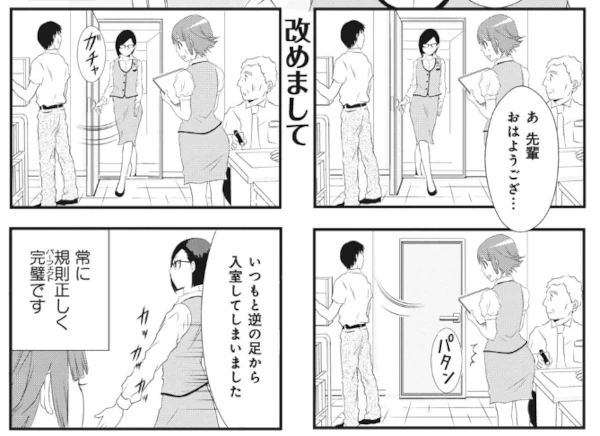This time, we’re introducing Ginko no Madoguchi—a lighthearted yet keigo-rich manga where business etiquette meets daily humor.
Work Information

Ginko no Madoguchi (銀子の窓口)
Author: Karakusa Michiru
Publisher: TAKESHOBO
Amount of text: moderate
Challenge level: ★★
Latest volume : Vol.6(Sep.2020 / Completed)
Story overview
Heartfelt service delivered with an icy (cool) gaze. Zero smiles—but flawless work. For some reason, customers can’t get enough of bank teller Ginko Shinonome. And when it comes to smug auditors, her cold stares come back twice as sharp!? From rising star manga artist Michiru Karakusa comes her very first gag 4-panel comic collection!
The Appeal of This Manga
At the center of the story are Ginko—robotically expressionless yet flawless in her work—and Neneko, a clumsy but cheerful new bank employee. Set in the unique workplace of a bank, the series humorously portrays unexpected incidents and quirky office routines. While Ginko is admired for her perfection, she’s also described as “robot-like,” with an unusual personality. Her junior Neneko, by contrast, is full of emotion and often makes silly mistakes. Surrounding them are eccentric coworkers and slightly odd customers, making for countless laugh-inducing episodes. It’s a lighthearted 4-panel manga that you can pick up and enjoy easily.

Why this manga is suitable for learning Japanese
This manga is not only entertaining but also highly recommended for Japanese learners for several reasons.
Plenty of business conversation examples at the bank
Since the story takes place in a bank and the main character works at the service counter, you’ll find many examples of polite customer-service language. In particular, Ginko and Neneko use honorific speech (keigo) in almost all their conversations, so the ratio of keigo in this manga is much higher than in most works.

Easy to read as a 4-panel comic
Because it’s structured as a 4-panel manga, each episode is short, making it easy to adjust your reading pace and volume. This makes it especially recommended for beginners learning Japanese.

Culture Spotlight
Banks in Japan: From Rigid Stability to a Changing Futureお堅い銀行
Japan is famous worldwide for its high level of customer service, often described with the word omotenashi (hospitality). Among all industries, banks stand out as places where politeness is pushed to the extreme. Because they deal with people’s money, every interaction is expected to be conducted with the utmost care, formality, and precision. At the teller window, even small phrases are carefully chosen in keigo (honorific speech) to maintain trust and respect.

Banks as the Symbol of Job Security
For much of Japan’s postwar history, banks and other financial institutions were seen as the most stable and prestigious employers. There was even a widespread belief that “banks never fail,” which made them especially popular workplaces for both men and women. A job at a bank meant lifelong stability, social status, and steady advancement—a dream career path in the eyes of many families.
The Collapse of the Myth
However, this “too big to fail” image collapsed dramatically with the bursting of the economic bubble in the 1990s. Several banks merged, downsized, or even failed outright—something previously thought impossible. The financial crisis left a deep scar on Japanese society, and the once rock-solid trust in banks as unshakable institutions was permanently weakened.
How the Pandemic Changed Bank Windows
Fast-forward to the 2020s, and bank teller services—once the face of Japanese politeness—have also changed. During the COVID-19 pandemic, in-person visits decreased sharply as customers shifted to online banking, ATMs, and smartphone apps. The traditional image of neatly dressed clerks serving customers at immaculate counters began to fade, replaced by digital screens and cashless convenience.
A New Era: Banks Must Earn, Not Just Guard
As of 2025, banks in Japan are undergoing a transformation. No longer viewed only as safe, rigid, and secure workplaces, they are now pressured to generate revenue through new business models, investments, and services. Instead of simply guarding deposits, banks are expected to compete, innovate, and “earn their keep.” This shift marks a cultural change: the image of banks as conservative fortresses of stability is giving way to a more dynamic, uncertain, and even entrepreneurial identity.
Why Learning Bank Teller Politeness Matters
Ginko no Madoguchi offers a rich look at teller–customer exchanges, showing how language itself builds trust.
For learners, studying this kind of keigo goes beyond memorizing honorifics—it reveals how politeness ensures reliability in customer service, especially in banking. By watching how characters handle greetings, apologies, and requests, you see keigo at work in high-stakes situations.
Even if face-to-face banking is less common today, these lessons remain valuable. Mastering such formality prepares you for interviews, offices, and any setting where respect and professionalism are key.
A Little Warning
Lots of fan service?
The manga contains some fan service—scenes that are added for their erotic appeal. If you’re not comfortable with that kind of content, it may not be the best choice for you.

Work Information

Ginko no Madoguchi (銀子の窓口)
Author: Karakusa Michiru
Publisher: TAKESHOBO
Amount of text: moderate
Challenge level: ★★
Latest volume : Vol.6(Sep.2020 / Completed)
Here’s a safe and convenient way to purchase Japanese manga.
This Blog’s ConceptIn this blog, we are introducing manga that are not only highly captivating but also ideal for Japanese language learners. Studying Japanese through manga is both fun and effective. Manga allows you to understand the subtleties of keigo (honorifics), teineigo (polite speech), and casual conversation in Japanese. We hope you find works that match your interests and use them to enhance your Japanese learning journey.